Beginner's Guide
Военно Исторический Клуб “Источник” (translated as Military History Club “Source”) or “Istochnik” for short, is an organization of Soviet/Russian reenactors in the Midwest United States dedicated to setting new standards of quality for reenacting events. We behave less like a traditional unit and more like a planning apparatus and a group of friends.
Anyone who meets our standards is welcome to attend events with us, but we reserve the right to terminate that relationship at any time. Full members of the club must own their own kit, and attend at least two events. Membership in the club will not interfere with membership of other reenacting “units”. There are several “units” who are a part of the club that fall under Istochnik appointed command and authenticity standards at Istochnik events.
It is important to note that historical reenacting is an expensive hobby. Most unit members report spending between $800-$1000 on their impressions by the end of their first year in the hobby alone. It is important to spend your money smartly, and take advantage of good deals when they are available. Antiquities and military surplus have volatile markets, and prices can fluctuate daily. We highly advise talking to unit members before buying anything.
We are an entirely apolitical group. We don’t support or tolerate support of the ideologies of the Soviet Union or Nazi Germany that caused so much suffering, or any other extremist ideology. We also don’t tolerate bullying or discrimination in any form. However, we enjoy joking around, often at each other’s expense, and we ask that members have thick enough skin to handle friendly banter.
Instead of a traditional command structure, for most public events, volunteer coordinators decide the ranks and roles for each person for each event based on merit and experience. There is no unit commander, but there is an “inner circle” of coordinators who lead the club and maintain the standards. Anyone who is willing and able to put in the necessary effort to coordinate events is welcome to help out, or host their own events. This does not apply to our large yearly immersion event, that event follows a strict chain of command with ranks distrusted amongst those who have earned it and shown they can handle the responsibility.
RECOMMENDED GEAR
Our standards vary depending on the event scenario, however, this is the basic gear that should allow you to portray most impressions. This list is far from definitive, and if you have any questions feel free to contact a coordinator.
-Recommended vendors:
**When you are first starting out, please ask another unit member for help buying items. It is very easy to buy the wrong things. Vendors will intentionally sell you mislabeled items. Literally every reenactor has been burned on something. We can help you avoid it.**
–Red Guard Militaria/ Дориан Мотовулак on facebook
-Green Star Artel/New Leningrad (on facebook/telegram)
-Artel Red October (on facebook)
–Schuster.ru, or their sales rep Yuri Drukarov (use discretion, and ask before buying)
-ebay.com (use discretion, and ask before buying)
Avoid Hikishop, Ostfront, Trident militaria, and Soviet Power for most items, although they do have some usable things.
-Rifle
mosin nagant M91/30: $300-500
This is the rifle most used
Also useable are:
Mosin Nagant M91 variations (1891-~1943), PPSh 41(1941-1945) , PPS43 (1943-1945), SVT-40 (1940-1945), and DP-27 (1928-1945)
-Helmet:
Ssh39(1939-43)$100-250
The most common helmet in the early war. Quality of repros varies considerably, so ask before buying.
Ssh40(1940-45)$30-60 eBay, Ostfront
Postwar helmets are incredibly similar, and can easily be modified to be identical to wartime helmets. The most versatile, and cheapest helmet. They are sized 1-3, so make sure the one you buy fits.
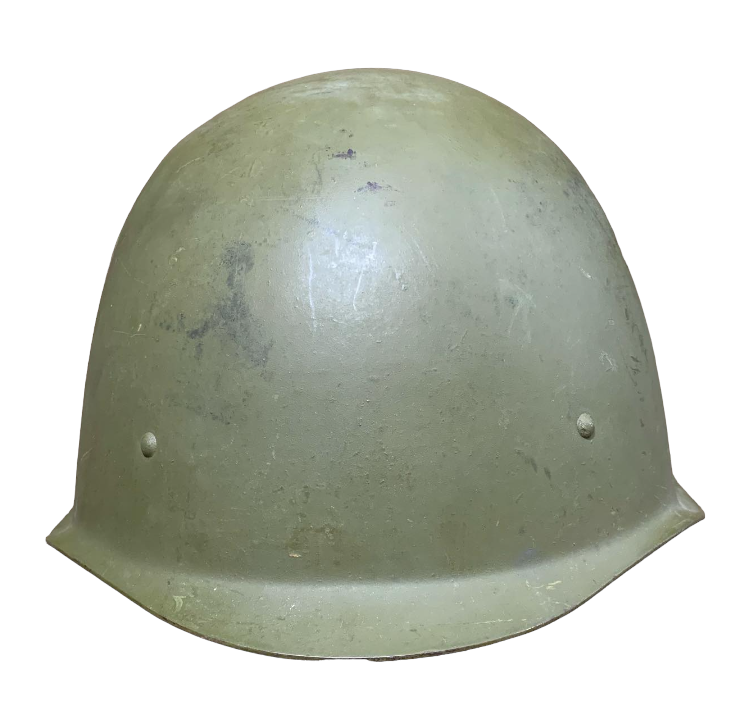
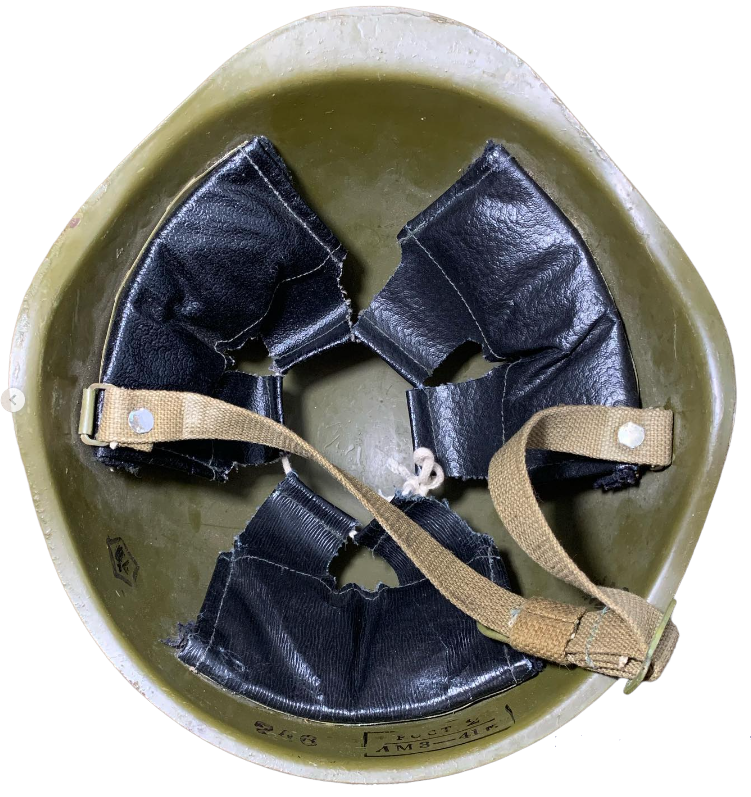
Uniform:
M35 Tunic(1935-~1943) $55-100
-Raspberry Collar tabs were worn from 1935-early 1942. Subdued collar tabs were worn from 1942-1943. Many tunics did not have collar tabs. Please ask about what collar tabs to use.
M43 Tunic (1943-1945)
-pocketless, worn with raspberry piped field shoulder boards for Infantry.
M35 pants (all war) $50-100
-no rear pocket
Boots: $40-120
Tall sapagi jack boots or lower boots worn with puttees. They had leather soles or rubber soles with a dot pattern wartime. “Tractor” patterned soles aren’t allowed. German boots are also acceptable. Message a coordinator for these. Correct boots that fit well are very important.
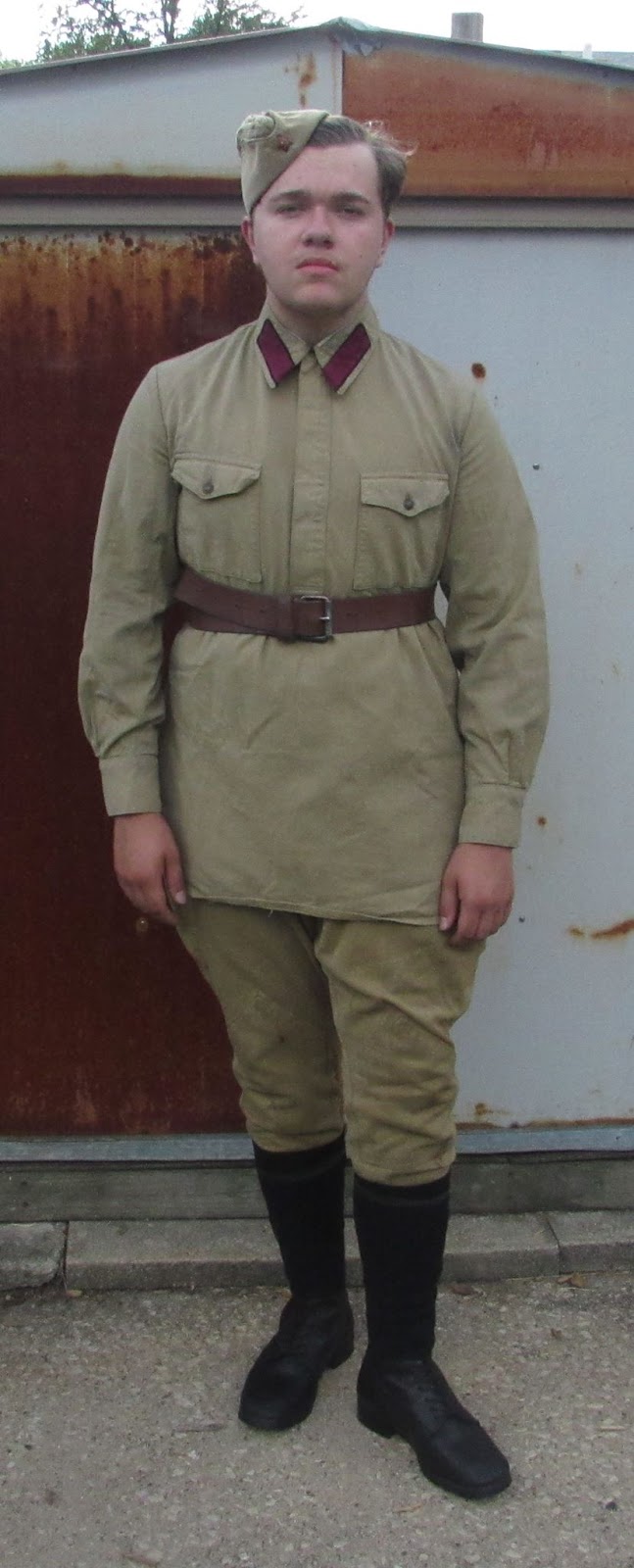
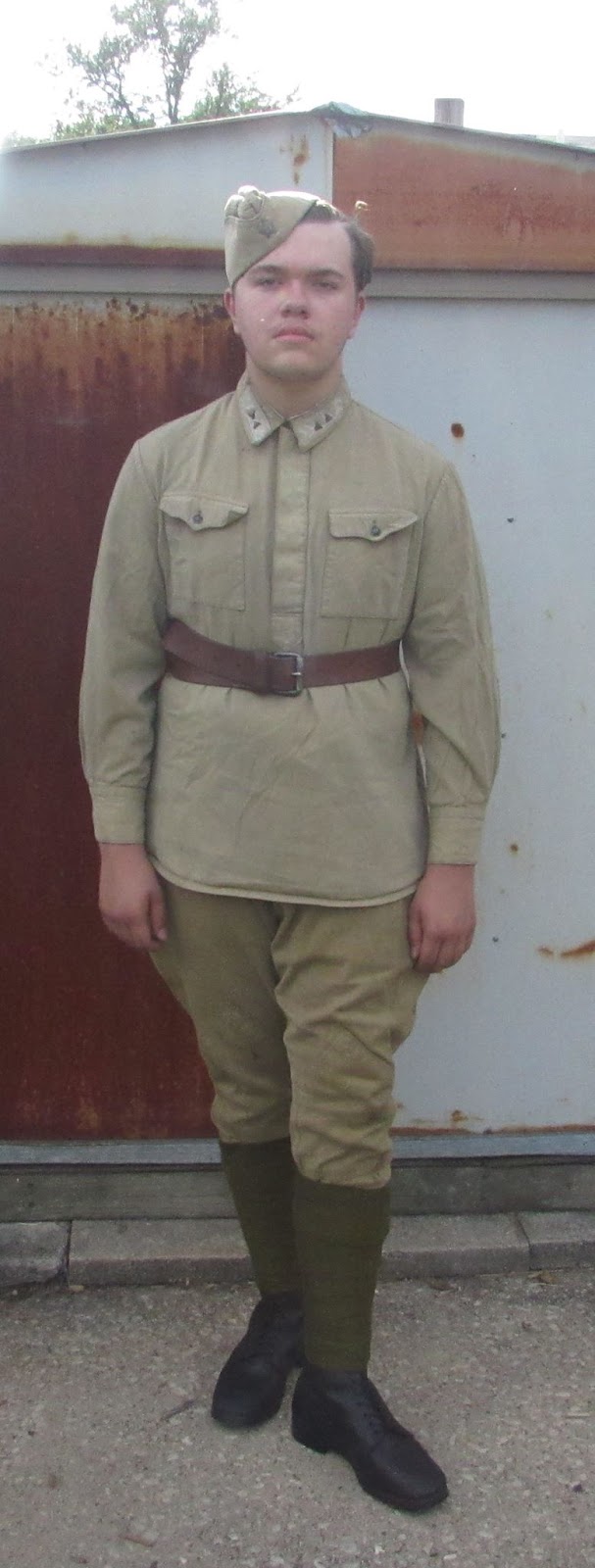
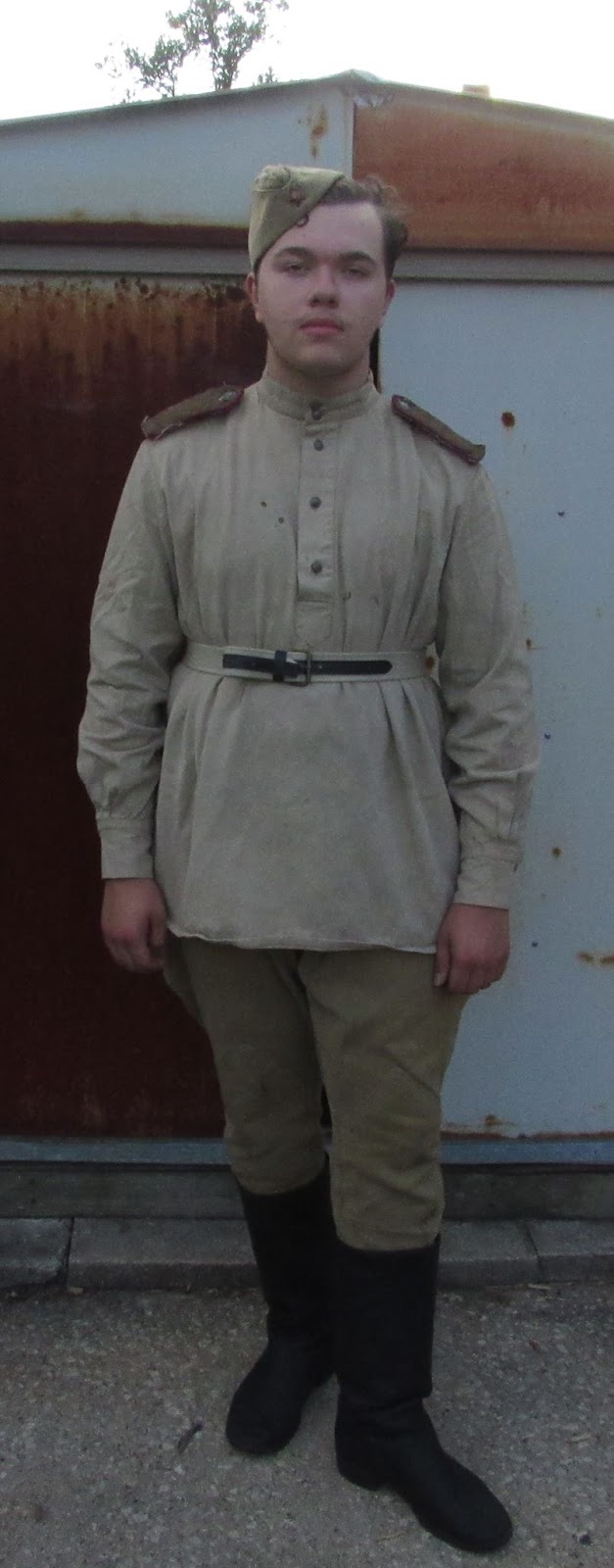
Above is the 3 main variations of wartime tunics. Left; Obr35 tunic with colored collar insignia. Center; Obr35 tunic with subdued collar insignia. Right; Obr43 tunic with a standing collar and shoulder boards (pagoni). The model wears low boots w/ black and green puttees (leg wraps), and the taller sapagi boots.
Shinel (overcoat, all war) $100-$300
-These were carried all year, as they made up your bedding in the summer. Recommended vendors: Schuster, Voin, or Voinspec. Postwar Obr1969 coats are usable, but not recommended.
Telogreika padded jacket/pants $50-100
-Issued as a liner for a shinel for extreme cold, but often worn alone. Postwar ones are usable with some easy modifications. You don’t *need* these but they’re highly recommended for winter events.
Ushanka hat $60-100 (1941-1945)
The Iconic russian winter ear hat. Baika(flannel) body with fake fur was by far the most common. Various uniform twill bodies were also seen, and sometimes wool. These were worn from fall to early spring.
Budenovka hat ~$60 (1932-~1942)
A symbol of the Civil War, this pointed flannel hat was intended to mimic the helmets of Russian knights. It was considered impractical, and largely replaced by the Ushanka by 1941. They are still occasionally seen through 1942.
Pilotka hat. $10-$20
A summer uniform side cap. Issued from spring-fall. Early postwar examples are acceptable for use.
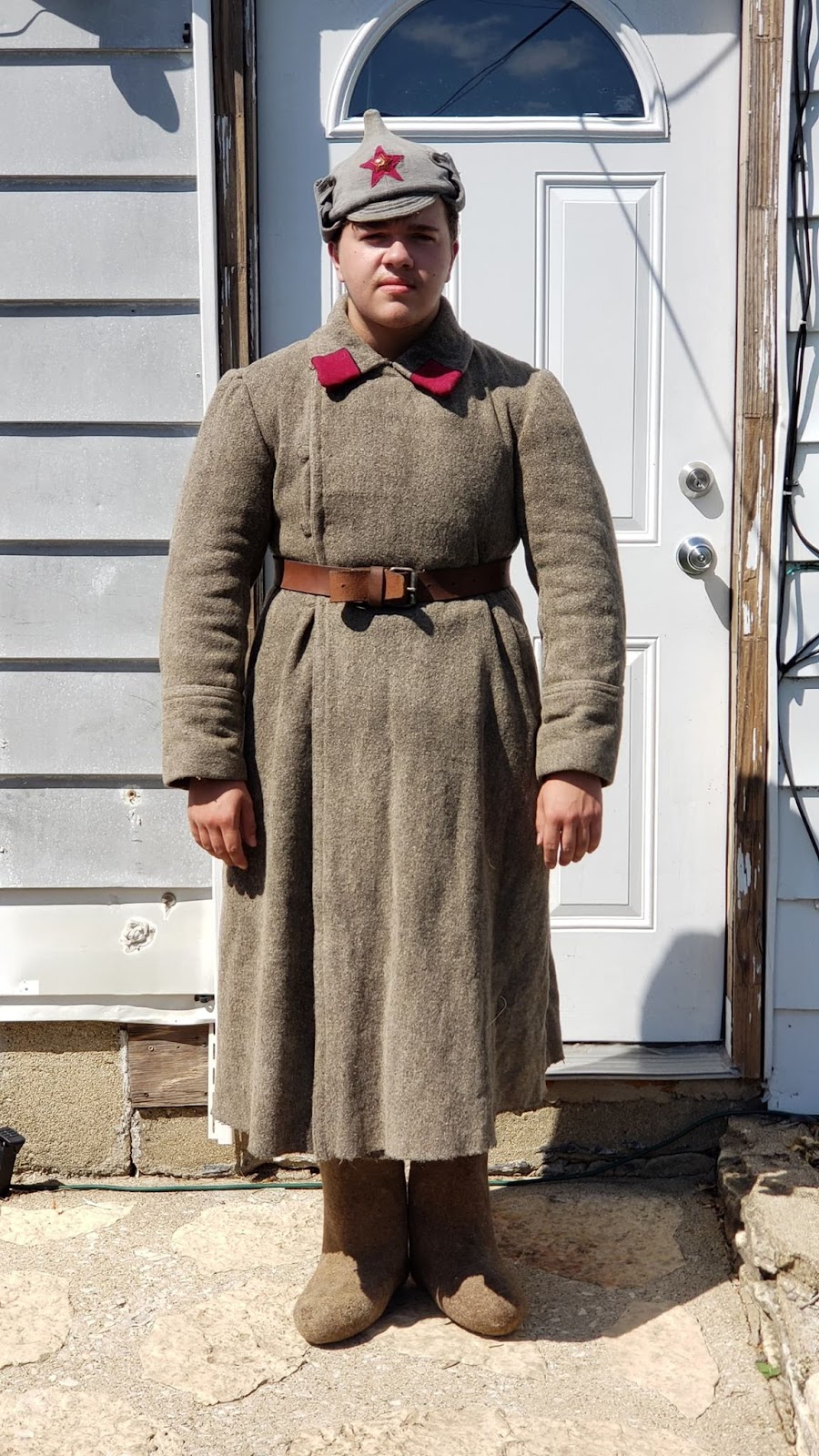
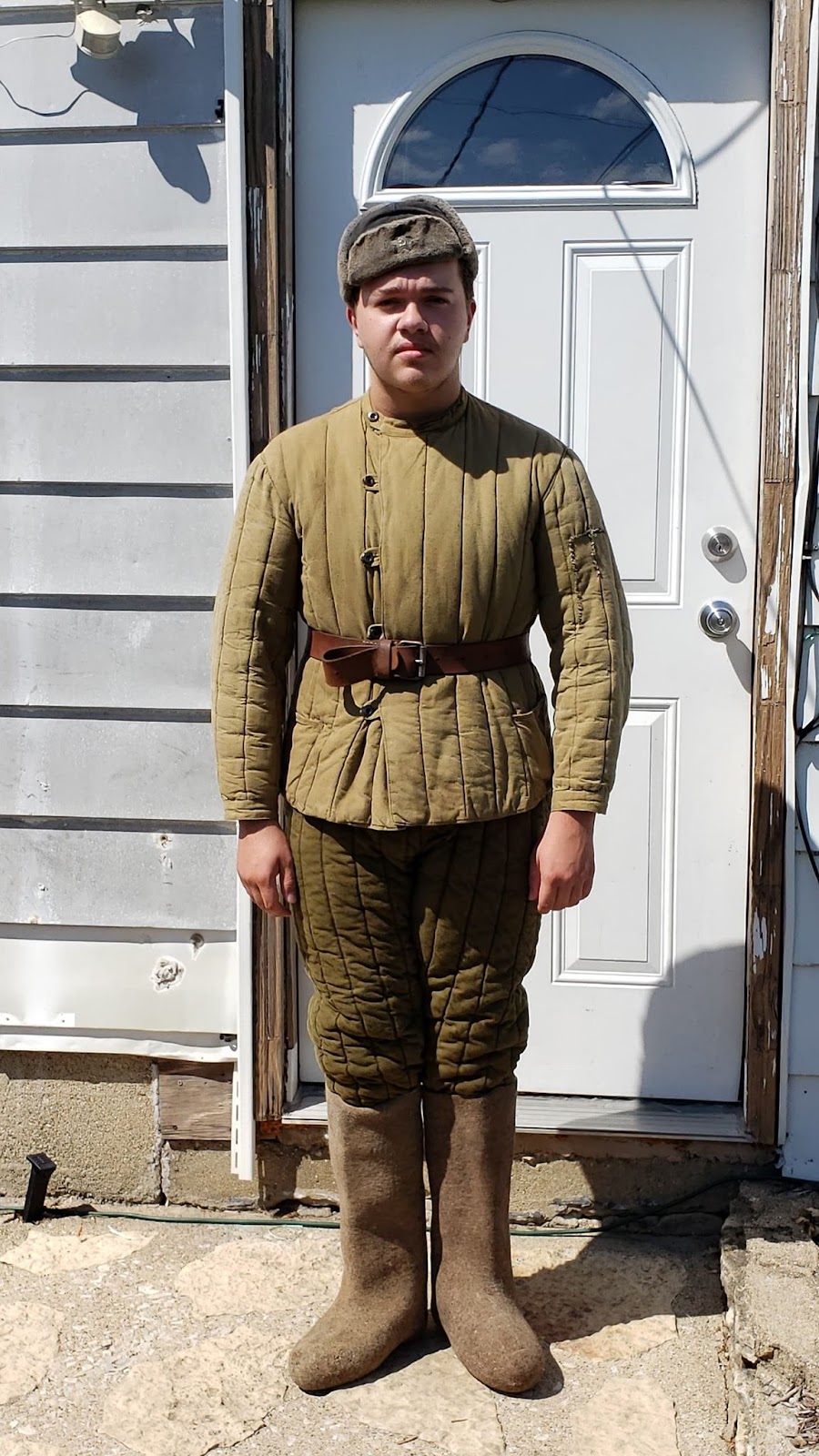
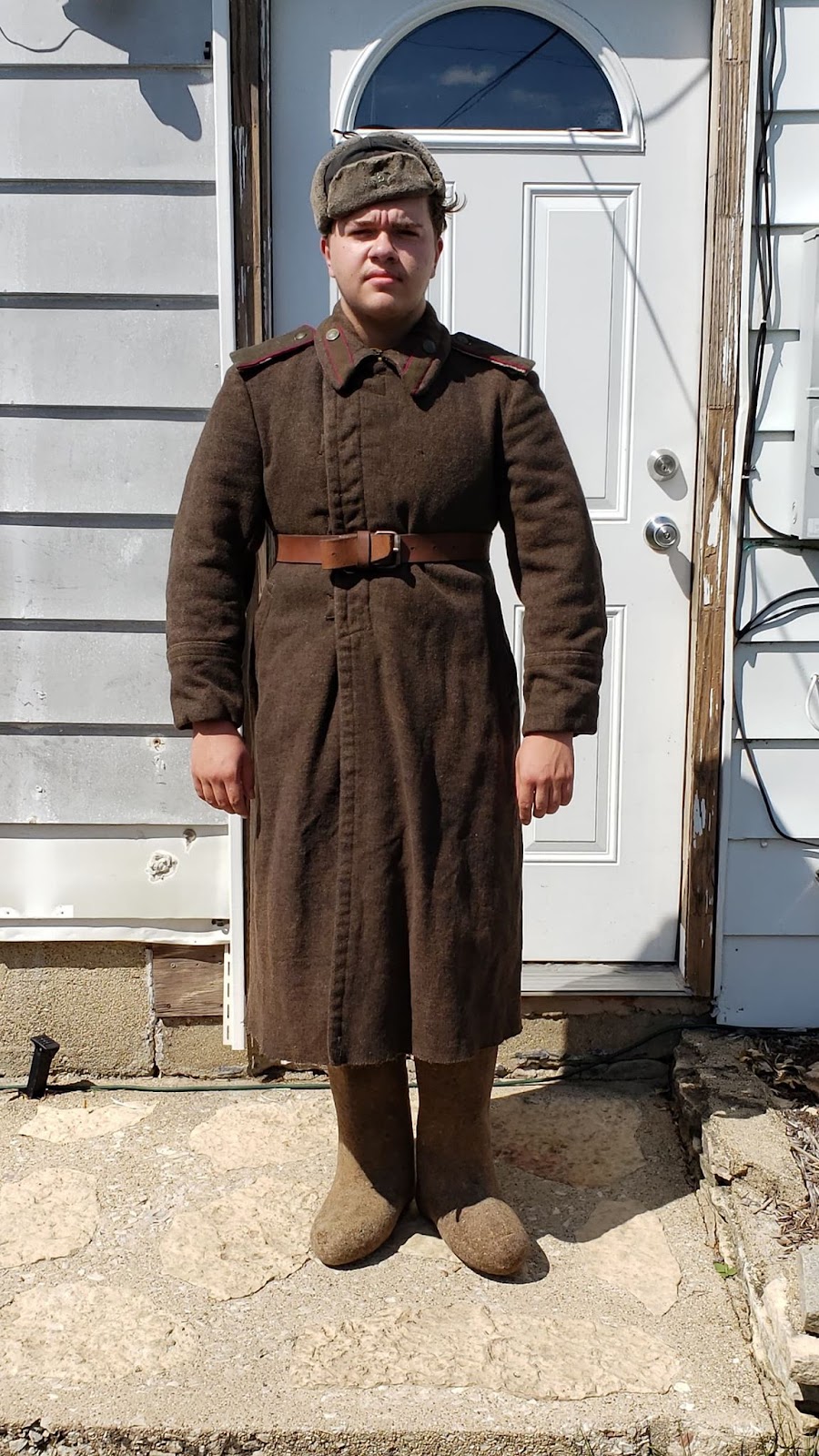
3 variations of winter gear through the war in the photos above.
The first photo represents the Winter War/Early war, and the model is wearing a shinel with color collar insignia, a budenovka, and valenki felt boots. The shinel collar insignia was subdued with the same order that subdued tunic collar insignia
The second photo shows the Obr32 telogreika/vatnik padded suit. It was often worn instead of the shinel in cold conditions, or under the shinel in extreme cold conditions. The model is also wearing an Ushanka hat, and valenki felt boots.
The third photo represents the post-January 1943 uniform changes. Shoulder Boards (Pagoni) and different collar tabs are added to the shinel. The model retains the Valenki felt boots and Ushanka hat.
-Equipment
M37 leather mosin pouch $25-60 ea.
East German reparations pouches are very similar, but many buy the much nicer pouches offered by red guard militaria. Keep them well oiled.
Platsch palatka (poncho/tent) $20-30
Surplus ones with leather grommets are correct. Buy on ebay or from most other vendors
Equipment Belt $40
Leather was common, but a canvas/leather economy version was also used. Buy from the red guard.
“Vyesh-Meshok” backpack $20-60
Sometimes called a turkestani pack in Russian. a simple bag which ties off on the top. Other backpacks were used early war, but this is the cheapest and most common. The style with bedroll straps and a pouch on the outside came out in 1958. Early postwar surplus is acceptable.
Mess kit $15-30
Either pot style or kidney style. German mess kits are also acceptable.
Spoon $5-15
Soviet civilian spoons preferred, but captured German or period civilian spoons are fine.
Canteen $40-60
Wartime ones had a much smaller thread on the cap than postwar. East German police canteens are identical. Glass canteens were also used, but not recommended because they break easily.
Where do I start?
We recommend that you start with the things that are more difficult to borrow. Such as: Boots, underwear, and your uniform. Next you should buy your personal items, mess kit and utensils, cold weather gear, and your weapon and field gear. Contact a unit member if you are missing something before an event, we have plenty of club loaner gear.
Impression Examples.
Operation Barbarossa (Summer/Fall 1941)
The Nazi invasion of the Soviet Union was a disastrous defeat for Soviet forces in the Western Military Districts.
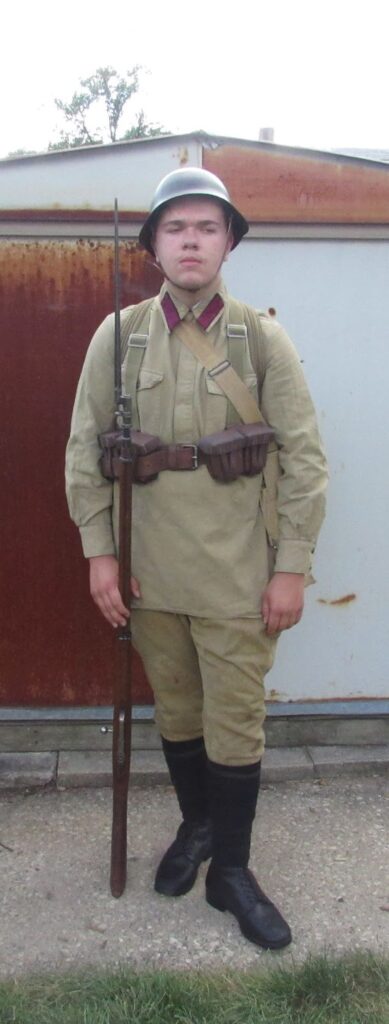
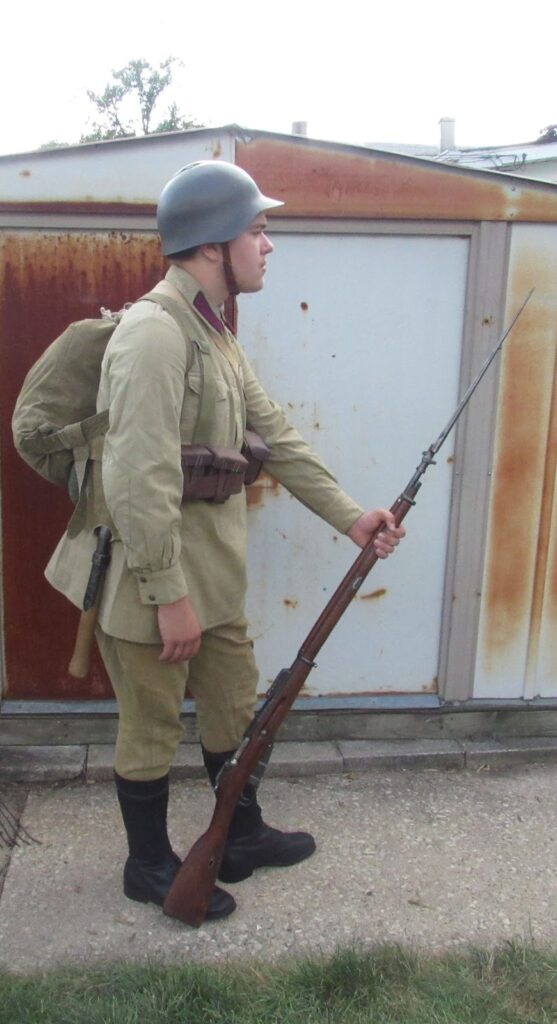
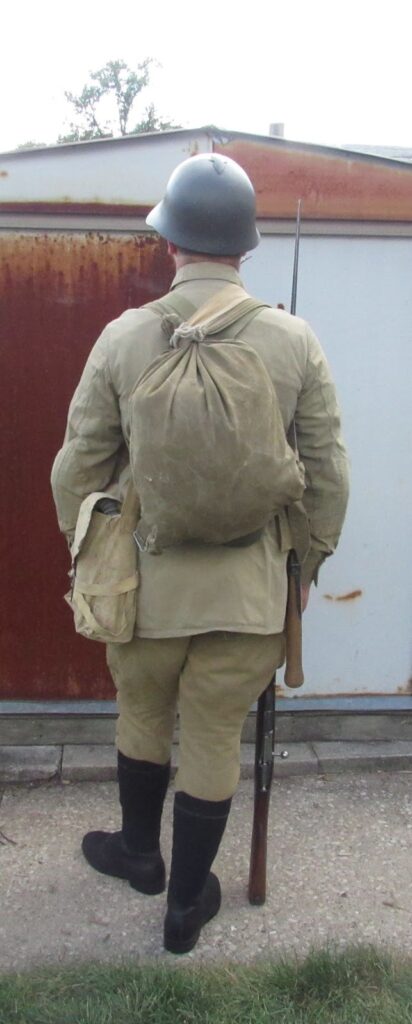
The model wears the Obr35 Tunic and Trousers with colored insignia, with low boots/black puttees and an SSh36 helmet. He wears a leather equipment belt, two leather pouches, a tsarist style entrenching tool, a canteen, an Obr38 Gas Mask bag with contents, and a meshok backpack. He is armed with the Mosin Nagant M1891 rifle.
Spring/Summer 1942.
Another series of disastrous defeats and heroic last stands as the Red Army was pushed deeper and deeper into the Soviet Union. Sevastopol, Demjansk, Voronezh, and Operation Blau all fall under this impression.
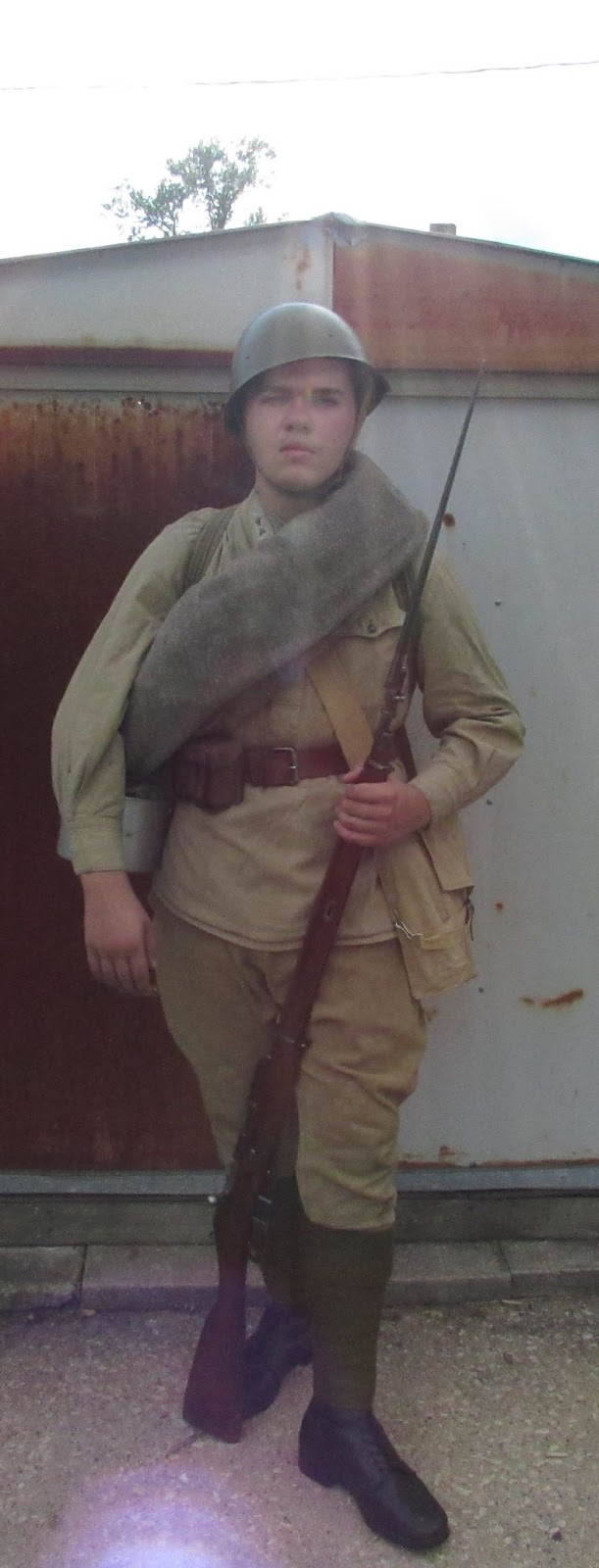
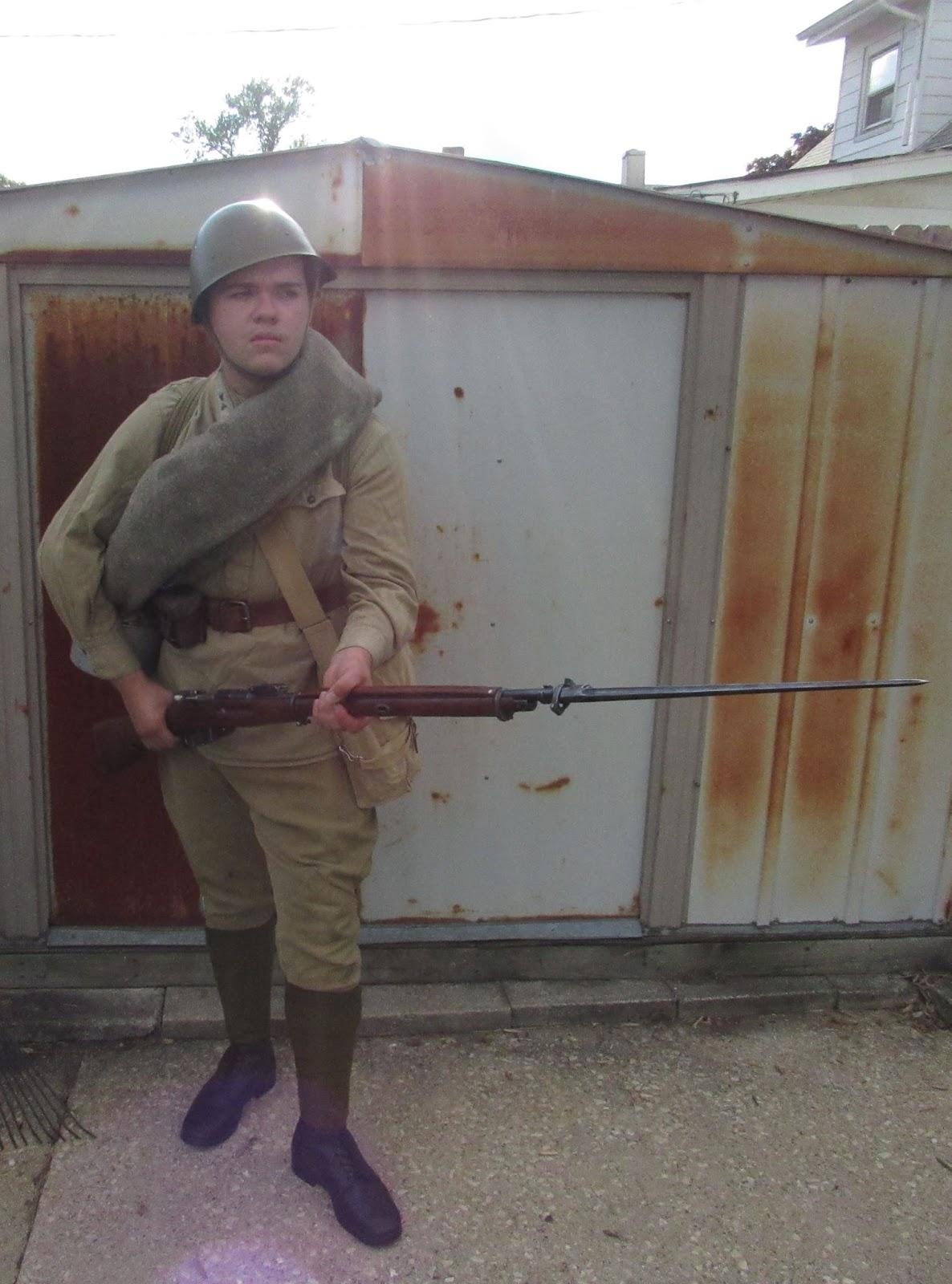
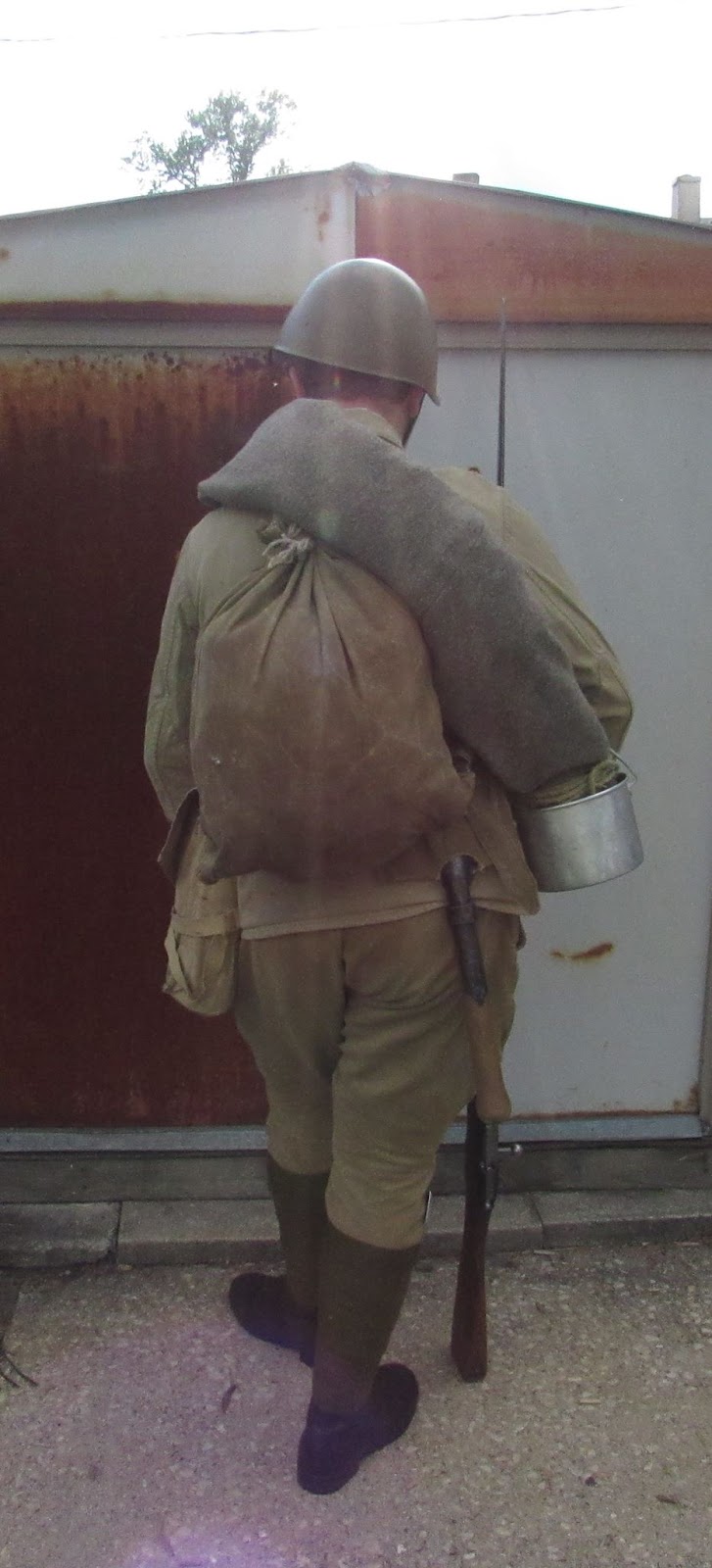
The model wears the Obr35 tunic/trousers with subdued insignia. He wears low boots with green puttees, and an SSh40 helmet. For field gear he wears his leather equipment belt, a single leather pouch, a canteen, a tsarist style entrenching tool, an Obr38 gas mask bag, and a meshok. He also wears a “skatka” roll, which consists of a shinel, and occasionally a Plash Palatka rolled into a horseshoe shape and secured with a strap. He has secured his mess pot into the skatka strap.

